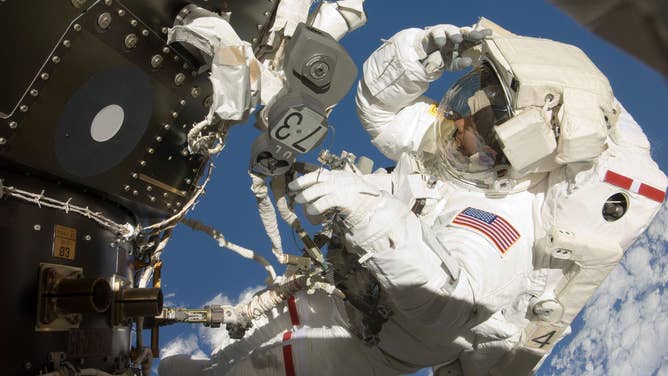Risk to spacewalkers increases only slightly due to Russian space debris, NASA says
Russian space debris still needs to be cataloged

In this NASA photo Astronaut Tom Marshburn participates in his first spacewalk outside the International Space Station on July 20, 2009. Marshburn will conduct his fifth career spacewalk on Nov. 30, 2021 alongside NASA Astronaut Kayla Barron.
(NASA)
Spacewalking is already risky, yet NASA is still working to understand how much more danger astronauts will face after a Russian test created thousands of pieces of additional space debris in low-Earth orbit.
The first spacewalk since Russia conducted an anti-missile test intentionally destroying its satellite is planned for Tuesday morning.
NASA astronauts Kayla Barron and Tom Marshburn are scheduled to exit the International Space Station airlock around 6 a.m. They will spend over 6 hours outside the space station to replace a faulty communication antenna system on its truss structure. NASA managers said the antenna could no longer send data back to Earth, but it could still upload to the station. Before it went down, the antenna worked on the space station for more than 20 years.
During a news conference, Monday NASA managers spoke about how the agency calculates the risk of a spacewalk, also known as an extravehicular activity or EVA. It was a more complicated process for this EVA after Russia destroyed one of its satellites during an Anti-Satellite (ASAT) test earlier this month, creating approximately 1,500 pieces of space junk and forcing the seven astronauts to shelter. NASA said every 90 minutes; the ISS would pass near the debris field.
NASA's ISS deputy program manager Dana Weigel said the spacewalk this week is at an elevated risk for a debris strike to the crew by 7%. However, she stressed that it is within the same risk "family" as previous spacewalks over the last few years.
LEARN: Why space trash will continue to be a problem in low-Earth orbit
"EVA has always been risky. And so though the 7% is a small increase," Weigel said.
Astronauts wear pressurized spacesuits outside the ISS that are essentially mini-spacecraft to keep them alive. These are more vulnerable to smaller pieces of space debris than the ISS, Weigel explained.
"There are so many more smaller pieces of debris mostly contributed by micrometeoroids and naturally occurring events," she said.
She said the normal risk is around a 1 in 2,700 chance of having some kind of space debris penetrate a spacesuit during a spacewalk.
To determine the danger to the crew, NASA runs different models and predictions to understand what the debris environment will be for the spacewalk.
"The 7% in and of itself is not a large increase, and that's well within what we see with normal atmospheric fluctuations and the normal amount of debris that kind of moves through," Weigel said.

NASA astronauts Raja Chari, Tom Marshburn, Kayla Barron, and ESA astronaut Matthias Maurer pose for a photo with NASA astronaut Mark Vande Hei and Russian cosmonauts Anton Shkaplerov and Pyotr Dubrov after arriving on space station on Nov. 11, 2021.
(NASA)
However, most of the new pieces created by the Russian test are still being added to the debris tracking databases.
The Department of Defense's global Space Surveillance Network sensors track nearly 30,000 pieces of space debris. Some of these items include rocket hardware and defunct satellites. However, some trash is too small to be tracked.
As of April 2021, NASA estimated that all the space debris in orbit has a collective mass of 9,300 metric tons.
"There are about 1,700 new objects, larger objects that are being tracked. It will take a few months to get all of those cataloged and into our normal debris tracking process, where we can then assess miss distances or how close these items get to ISS," Weigel said. "That's still work in front of us as those items get cataloged."
NASA spacewalk Officer Art Thomason said the astronauts would stick to the job at hand Tuesday even if they finish early. When astronauts have additional time in a spacewalk, they perform "get ahead" maintenance work outside the space station.
Weigel said NASA was "conservative in eliminating things from the spacewalk" like extra tasks because they didn't yet understand the new debris risk increase.
NASA will air the spacewalk on NASA TV and NASA.gov.
Barron and Marshburn will be recognizable by their suits and how mission managers refer to them during the spacewalk. Barron will be called EV2 and will have white stripes on hers, and Marshburn will be EV1 and wearing the suit with the red stripes.
For most of the EVA, Marshburn will be attached to the robotic Canadaarm2 working alongside Barron. European Space Agency Astronaut Matthias Maurer will control the robotic arm from inside the space station.
The spacewalk will be Barron's first and Marshburn's fifth.